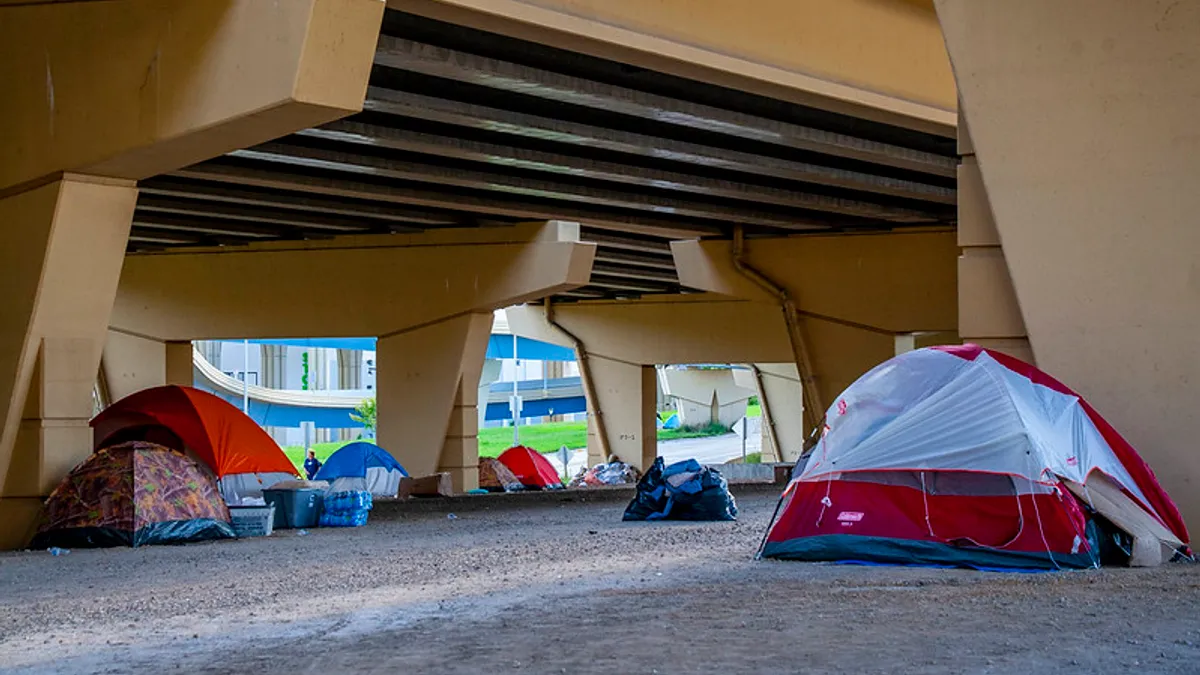Dive Brief:
- People live in homeless encampments largely due to a lack of affordable housing and shortcomings in local shelter systems, according to a study released this month by Abt Associates for the U.S. Department of Housing and Urban Development (HUD) and the Department of Health and Human Services.
- The study is purportedly the first federal study of homeless encampments. Its methodology includes a literature review, interviews with officials from nine cities — Chicago; Houston; Fresno, CA; San Jose, CA; Philadelphia; Portland, OR; Las Vegas; Minneapolis; and Tacoma, WA — and site visits to Chicago, Houston, San Jose and Tacoma.
- Among four of the nine cities studied, city governments were found to be the most significant funders of encampment responses. Those four cities spent between $3.4 million and $8.5 million in fiscal year 2019 on community responses to encampment.
| Total FY19 homeless encampment spend | Unsheltered FY19 homeless population | Cost per unsheltered homeless person | |
|---|---|---|---|
| Chicago | $ 3,572,000 | 1,260 | $2,835 |
| Houston | $ 3,393,000 | 1,614 | $2,102 |
| Tacoma | $ 3,905,000 | 629 | $6,208 |
| San Jose | $ 8,557,000 | 7,922 | $1,080 |
Dive Insight:
The report's other key findings include that a diverse set of partners — the mayor's office, local environmental groups, and city solid waste and sanitation and transportation departments — were involved in clearing and closing encampments, while also offering outreach services to individuals living at the encampment.
And while lack of affordable housing is one of the key reasons individuals live in encampments, other reasons include various barriers to entry in shelter systems, according to the report. Some shelters also include rules or expectations that aren't compatible with resident needs like forbidding pets or requiring that individuals be sober and that male and female guests be separated, said Lauren Dunton, a report author and senior associate at Abt Associates. Some individuals also feel unsafe at shelters, she said.
"Encampments really offer a sense of family or community, especially for people that maybe are not in a position to have a big personal support," Dunton said.
To support future encampment response efforts and outreach to individuals experiencing homelessness, cities are exploring new avenues to fund that work, according to the report. And state and federal governments should also seek ways to free up funding for outreach and encampment responses.
The report was published in 2019 as encampments appeared "in numbers not seen in almost a century," according to Abt Associates. The coronavirus has only "heightened" these issues, Dunton said in a statement.
The country's homeless population increased for the fourth year in a row in 2020, according to HUD. There were over 580,000 individuals experiencing homelessness counted on a single night in January, prior to widespread pandemic effects in the U.S., representing a 2% increase compared to 2019.
"The 2020 report provides a deeply troubling accounting of homelessness in the United States," Nan Roman, president and CEO of the National Alliance to End Homelessness, said in a statement. "These results were tabulated practically on the eve of the COVID-19 pandemic, and they show a system under-resourced to meet the needs of people experiencing and at risk of homelessness, much less the coming consequences of the global pandemic and recession."
At the onset of the pandemic, the Centers for Disease Control and Prevention (CDC) recommended cities do not clear homeless encampments due to the public health risk of spreading the coronavirus. But many cities have ignored those guidelines.
New York, for example, doubled the number of encampments it "cleaned up," while almost 102 people have died of coronavirus in group shelters and 12 have died living on the streets, The New York Times reports. Cities in California, Washington and New York have also cleared encampments despite CDC guidelines.
And while some of the cities in the federal study used strategies around clearing and closing encampments with resource-intensive support for individuals, at least one city said this strategy can still exacerbate the challenges of helping residents move to shelter or permanent housing, "which is the most cost-effective and humane strategy, long-term," the report reads.












